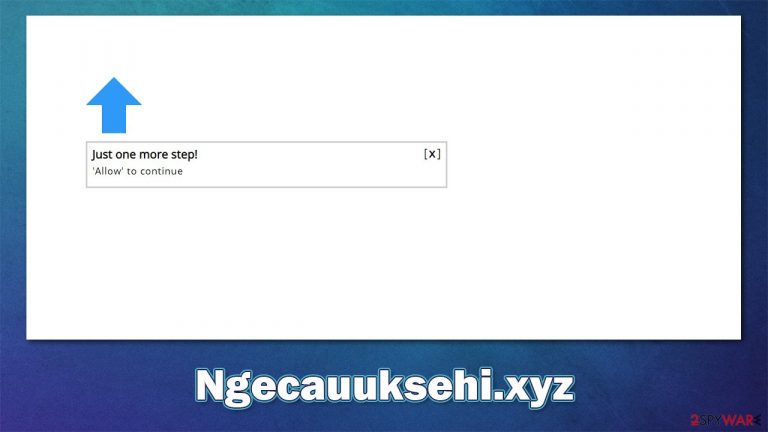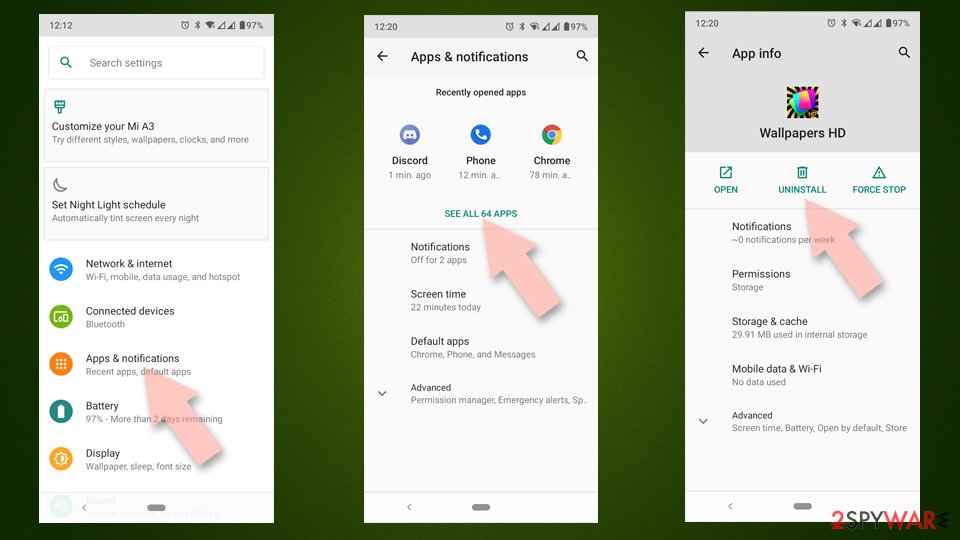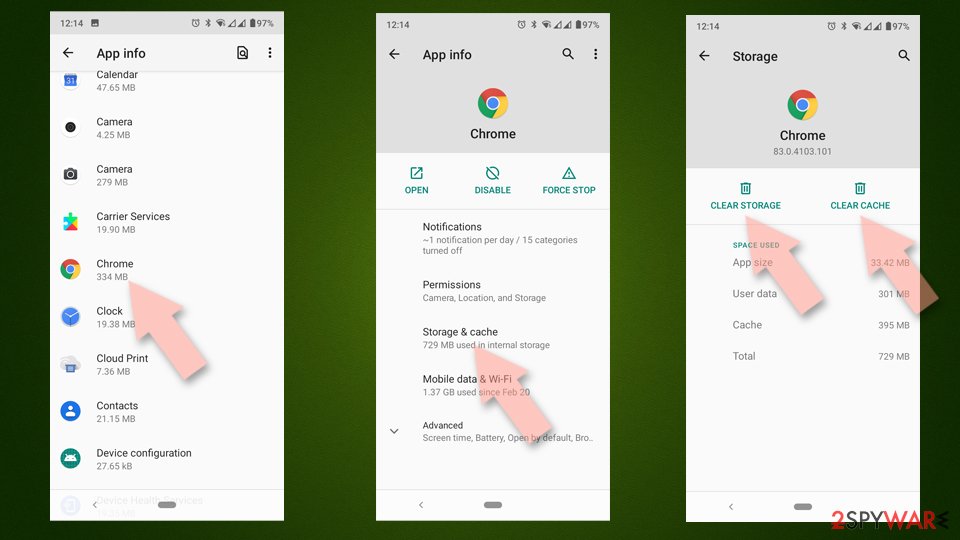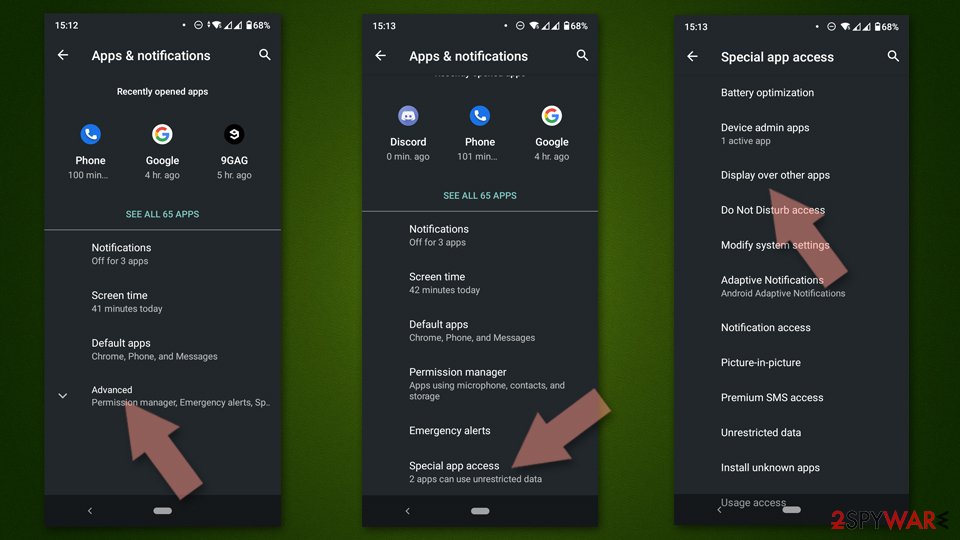Ngecauuksehi.xyz ads (scam) - Free Instructions
Ngecauuksehi.xyz ads Removal Guide
What is Ngecauuksehi.xyz ads?
Ngecauuksehi.xyz is a malicious website designed to scam users

While everybody once in a while encounters some ads while browsing the web, some of them can be particularly intrusive and annoying – they can cover the important parts of the website and might result in unintentional clicks. However, the matter becomes much more serious when the ads are not triggered by a website entry but rather show up randomly.
Ngecauuksehi.xyz is a scam website that ensures a continuous flow of advertisements that show up at random times. These notifications are also shown on top of all the other running apps and can easily disrupt anything that users are doing at the time, including visiting their favorite websites, streaming a video, or playing a game.
For the most part, they are unpleasantly surprised that the pop-ups show up like this and struggle to understand where are they coming from. Without a doubt, such activity can not only ruin people's mood but also put their security in danger, as the Ngecauuksehi.xyz ads might include links to deceptive and malicious websites, and they can be clicked by accident or due to misleading messages that the website delivers.
If you are experiencing this issue, you allowed the site to show notifications, be it intentionally or not. Users never visit the site intentionally but rather after being redirected from somewhere else, for example, after clicking on a deceptive link. This is where they are convinced that pressing the Allow button is the right thing to do. Luckily, this approval can be undone, and the intrusive pop-ups removed.
Note that redirects to suspicious websites are one of the main signs of the adware infection, so we will include a section on how to deal with that problem as well.
| Name | Ngecauuksehi.xyz |
| Type | Push notifications, ads, pop-ups, scam |
| Infiltration | Pop-ups start showing up at some point after the “Allow” button is pressed within the notification prompt |
| Symptoms | Intrusive desktop notifications show up on the desktop at any time, promoting dubious websites |
| Damage | Ads and links to sites displayed by the website might be dangerous: users might suffer from financial losses, disclose their sensitive information to unknown parties or install malware/PUPs on their systems |
| Elimination | You can stop the intrusive notifications by accessing web browser settings, as explained in the instructions below. If you suspect adware infection, you should scan your machine with SpyHunter 5Combo Cleaner or another security application |
| Further steps | After removing the unwanted pop-ups and dealing with adware, |
Ads and push notifications: what's the difference?
Visually, Ngecauuksehi.xyz pop-ups might look like your regular ads – those that show up upon entering a random website. However, this is not the case, and there are many misconceptions surrounding the feature. Hopefully, we can shed some light on how it works and help users to avoid being victims of push notification scams in the future.
Push notifications were first introduced as a feature back in 2009 when Apple realized the potential and benefits it could bring to the mobile phone industry. Thanks to the notifications showing up on top of all other apps, it helps users to notice relevant information faster. In 2015, Google launched the feature as well, and now it is included in most of the website's creation process.[1]
Since then, other browsers also adapted the API,[2] and now you can receive a prompt to allow notifications on many legitimate websites. It is undeniable that the component can be useful for people who want to receive the newest information from websites they love but in most cases, people dislike it overall. It is just another step they need to take to view the contents. In fact, Mozilla's analysis showed that 50% of people block notifications straight away, while in 99% of cases the notifications remained unaccepted.[3]
This is why the browser maker decided to ship its product with notifications being sent to the “silent” mode – it no longer disturbs people. In Chrome, it still works as an opt-out option, so those using this browser are likely to be subjected to push notification scams.
How crooks abuse legitimate features
The pop-ups from Ngecauuksehi.xyz are not only intrusive, but they also can be dangerous. It is not uncommon for these websites to show dubious content, such as get-rich-quick schemes or claims that the system is infected, and similar scams. This is done for only one reason – to ensure that creators receive ad revenue; they often employ unreliable ad networks, hence ads are almost always of poor quality.

Evidently, nobody would subscribe to notifications that deliver malicious links. Therefore, scam websites are created to make users do it without realizing what they have actually done. For example, a visitor can be redirected from a website that hosts illegal video streams. After clicking the “Play” button, they might end up on a push notification scam site that shows one of the following messages:
Press “Allow” to watch the video
Click the Allow button to subscribe to notifications and continue watching
For those who are less familiar with the push notification feature, clicking the “Allow” button makes a lot of sense. Only after they do it, they realize that there is no video to be shown and no more content to explore. They are then redirected to another similar site (Loptyinterva.xyz, Cellsignclock.top, or Wholedailyfeed.com), and then either repeat the mistake or close down the browser tab. Unfortunately, permission to show notifications has already been granted.
As long as you don't click on links provided within the prompt, you should be safe. Proceed with the instructions to get rid of the unwanted pop-ups once and for all.
Remove Ngecauuksehi.xyz ads
Since the disruptive activity does not start for some time after the notifications are accepted, people fail to understand what is causing them. This is also the case because many are tricked into pressing the Allow button, all while thinking that its function is not what it actually is.
If you are struggling with Ngecauuksehi.xyz removal, do not worry – fust follow the steps below. We provide guidelines for all modern web browsers.
Google Chrome (desktop):
- Open Google Chrome browser and go to Menu > Settings.
- Scroll down and click on Advanced.
- Locate the Privacy and security section and pick Site Settings > Notifications.
- Look at the Allow section and look for a suspicious URL.
- Click the three vertical dots next to it and choose Block. This should remove unwanted notifications from Google Chrome.

Google Chrome (Android):
- Open Google Chrome and tap on Settings (three vertical dots).
- Select Notifications.
- Scroll down to the Sites section.
- Locate the unwanted URL and toggle the button to the left (Off setting).

Mozilla Firefox:
- Open Mozilla Firefox and go to Menu > Options.
- Click on Privacy & Security section.
- Under Permissions, you should be able to see Notifications. Click the Settings button.
- In the Settings – Notification Permissions window, click on the drop-down menu by the URL in question.
- Select Block and then click on Save Changes. This should remove unwanted notifications from Mozilla Firefox.

MS Edge (Chromium):
- Open Microsoft Edge, and go to Settings.
- Select Site permissions.
- Go to Notifications on the right.
- Under Allow, you will find the unwanted entry.
- Click on More actions and select Block.

Safari:
- Click on Safari > Preferences…
- Go to the Websites tab and, under General, select Notifications.
- Select the web address in question, click the drop-down menu and select Deny.

Additional security tips
You might encounter online scams at any point while browsing the web, thus it is vital to stay vigilant at all times and be aware of them. Always pay attention to the website's URL – it can tell a lot whether or not it is genuine. When it comes to push notifications, always keep in mind that the “Allow” button always results in the same outcome – you allow the site to send you information without restrictions.
To secure your web browsing routine, you should also employ security apps that could help you. Anti-malware tools such as SpyHunter 5Combo Cleaner or Malwarebytes can warn you about the incoming danger and flag malicious links or files online. Ad-blockers can also serve as a good way of preventing malicious scripts from being executed.
Finally, you should also check your computer for adware – refer to the instructions below for details. Additionally, we recommend using FortectIntego PC repair software that would help you to fix the damage done to your system (if such exists due to malware infections or other reasons) and help you clean your browsers from cookies, caches, and other web data to ensure proper elimination of potentially unwanted programs.
Getting rid of Ngecauuksehi.xyz ads. Follow these steps
Uninstall from Android
Uninstall unwanted programs from Android device:
- Go to Settings -> Apps/Applications.
- Expand the full list of the installed apps.
- Scroll through the list and tap on a suspicious application once.
- Tap on it and select Uninstall.

- Reboot the device.
Clear Storage and data files on Android from Google Chrome or other apps:
- Go to Settings > Apps/Applications.
- Expand the full list of the installed apps.
- Tap on Chrome and select Storage & cache.
- Clear storage and clear cache of the app.

If you are seeing ads on top of other apps but are not sure what is causing it, perform the following steps:
- Go to Apps/Applications.
- Tap Advanced.
- Select Special App access.
- Tap on Display over other apps.

- Eliminate apps with these access rights enabled.
Uninstall from Windows
Instructions for Windows 10/8 machines:
- Enter Control Panel into Windows search box and hit Enter or click on the search result.
- Under Programs, select Uninstall a program.

- From the list, find the entry of the suspicious program.
- Right-click on the application and select Uninstall.
- If User Account Control shows up, click Yes.
- Wait till uninstallation process is complete and click OK.

If you are Windows 7/XP user, proceed with the following instructions:
- Click on Windows Start > Control Panel located on the right pane (if you are Windows XP user, click on Add/Remove Programs).
- In Control Panel, select Programs > Uninstall a program.

- Pick the unwanted application by clicking on it once.
- At the top, click Uninstall/Change.
- In the confirmation prompt, pick Yes.
- Click OK once the removal process is finished.
Delete from macOS
Remove items from Applications folder:
- From the menu bar, select Go > Applications.
- In the Applications folder, look for all related entries.
- Click on the app and drag it to Trash (or right-click and pick Move to Trash)

To fully remove an unwanted app, you need to access Application Support, LaunchAgents, and LaunchDaemons folders and delete relevant files:
- Select Go > Go to Folder.
- Enter /Library/Application Support and click Go or press Enter.
- In the Application Support folder, look for any dubious entries and then delete them.
- Now enter /Library/LaunchAgents and /Library/LaunchDaemons folders the same way and terminate all the related .plist files.

Remove from Microsoft Edge
Delete unwanted extensions from MS Edge:
- Select Menu (three horizontal dots at the top-right of the browser window) and pick Extensions.
- From the list, pick the extension and click on the Gear icon.
- Click on Uninstall at the bottom.

Clear cookies and other browser data:
- Click on the Menu (three horizontal dots at the top-right of the browser window) and select Privacy & security.
- Under Clear browsing data, pick Choose what to clear.
- Select everything (apart from passwords, although you might want to include Media licenses as well, if applicable) and click on Clear.

Restore new tab and homepage settings:
- Click the menu icon and choose Settings.
- Then find On startup section.
- Click Disable if you found any suspicious domain.
Reset MS Edge if the above steps did not work:
- Press on Ctrl + Shift + Esc to open Task Manager.
- Click on More details arrow at the bottom of the window.
- Select Details tab.
- Now scroll down and locate every entry with Microsoft Edge name in it. Right-click on each of them and select End Task to stop MS Edge from running.

If this solution failed to help you, you need to use an advanced Edge reset method. Note that you need to backup your data before proceeding.
- Find the following folder on your computer: C:\\Users\\%username%\\AppData\\Local\\Packages\\Microsoft.MicrosoftEdge_8wekyb3d8bbwe.
- Press Ctrl + A on your keyboard to select all folders.
- Right-click on them and pick Delete

- Now right-click on the Start button and pick Windows PowerShell (Admin).
- When the new window opens, copy and paste the following command, and then press Enter:
Get-AppXPackage -AllUsers -Name Microsoft.MicrosoftEdge | Foreach {Add-AppxPackage -DisableDevelopmentMode -Register “$($_.InstallLocation)\\AppXManifest.xml” -Verbose

Instructions for Chromium-based Edge
Delete extensions from MS Edge (Chromium):
- Open Edge and click select Settings > Extensions.
- Delete unwanted extensions by clicking Remove.

Clear cache and site data:
- Click on Menu and go to Settings.
- Select Privacy, search and services.
- Under Clear browsing data, pick Choose what to clear.
- Under Time range, pick All time.
- Select Clear now.

Reset Chromium-based MS Edge:
- Click on Menu and select Settings.
- On the left side, pick Reset settings.
- Select Restore settings to their default values.
- Confirm with Reset.

Remove from Mozilla Firefox (FF)
Remove dangerous extensions:
- Open Mozilla Firefox browser and click on the Menu (three horizontal lines at the top-right of the window).
- Select Add-ons.
- In here, select unwanted plugin and click Remove.

Reset the homepage:
- Click three horizontal lines at the top right corner to open the menu.
- Choose Options.
- Under Home options, enter your preferred site that will open every time you newly open the Mozilla Firefox.
Clear cookies and site data:
- Click Menu and pick Settings.
- Go to Privacy & Security section.
- Scroll down to locate Cookies and Site Data.
- Click on Clear Data…
- Select Cookies and Site Data, as well as Cached Web Content and press Clear.

Reset Mozilla Firefox
If clearing the browser as explained above did not help, reset Mozilla Firefox:
- Open Mozilla Firefox browser and click the Menu.
- Go to Help and then choose Troubleshooting Information.

- Under Give Firefox a tune up section, click on Refresh Firefox…
- Once the pop-up shows up, confirm the action by pressing on Refresh Firefox.

Remove from Google Chrome
Delete malicious extensions from Google Chrome:
- Open Google Chrome, click on the Menu (three vertical dots at the top-right corner) and select More tools > Extensions.
- In the newly opened window, you will see all the installed extensions. Uninstall all the suspicious plugins that might be related to the unwanted program by clicking Remove.

Clear cache and web data from Chrome:
- Click on Menu and pick Settings.
- Under Privacy and security, select Clear browsing data.
- Select Browsing history, Cookies and other site data, as well as Cached images and files.
- Click Clear data.

Change your homepage:
- Click menu and choose Settings.
- Look for a suspicious site in the On startup section.
- Click on Open a specific or set of pages and click on three dots to find the Remove option.
Reset Google Chrome:
If the previous methods did not help you, reset Google Chrome to eliminate all the unwanted components:
- Click on Menu and select Settings.
- In the Settings, scroll down and click Advanced.
- Scroll down and locate Reset and clean up section.
- Now click Restore settings to their original defaults.
- Confirm with Reset settings.

How to prevent from getting adware
Stream videos without limitations, no matter where you are
There are multiple parties that could find out almost anything about you by checking your online activity. While this is highly unlikely, advertisers and tech companies are constantly tracking you online. The first step to privacy should be a secure browser that focuses on tracker reduction to a minimum.
Even if you employ a secure browser, you will not be able to access websites that are restricted due to local government laws or other reasons. In other words, you may not be able to stream Disney+ or US-based Netflix in some countries. To bypass these restrictions, you can employ a powerful Private Internet Access VPN, which provides dedicated servers for torrenting and streaming, not slowing you down in the process.
Data backups are important – recover your lost files
Ransomware is one of the biggest threats to personal data. Once it is executed on a machine, it launches a sophisticated encryption algorithm that locks all your files, although it does not destroy them. The most common misconception is that anti-malware software can return files to their previous states. This is not true, however, and data remains locked after the malicious payload is deleted.
While regular data backups are the only secure method to recover your files after a ransomware attack, tools such as Data Recovery Pro can also be effective and restore at least some of your lost data.
- ^ A decade of push notifications: Where push is today. Adjust. Braze Blog.
- ^ API. Wikipedia. The free encyclopedia.
- ^ M.J. Kelly. Say goodbye to annoying notification requests (unless you want them). Mozilla. Firefox news.
